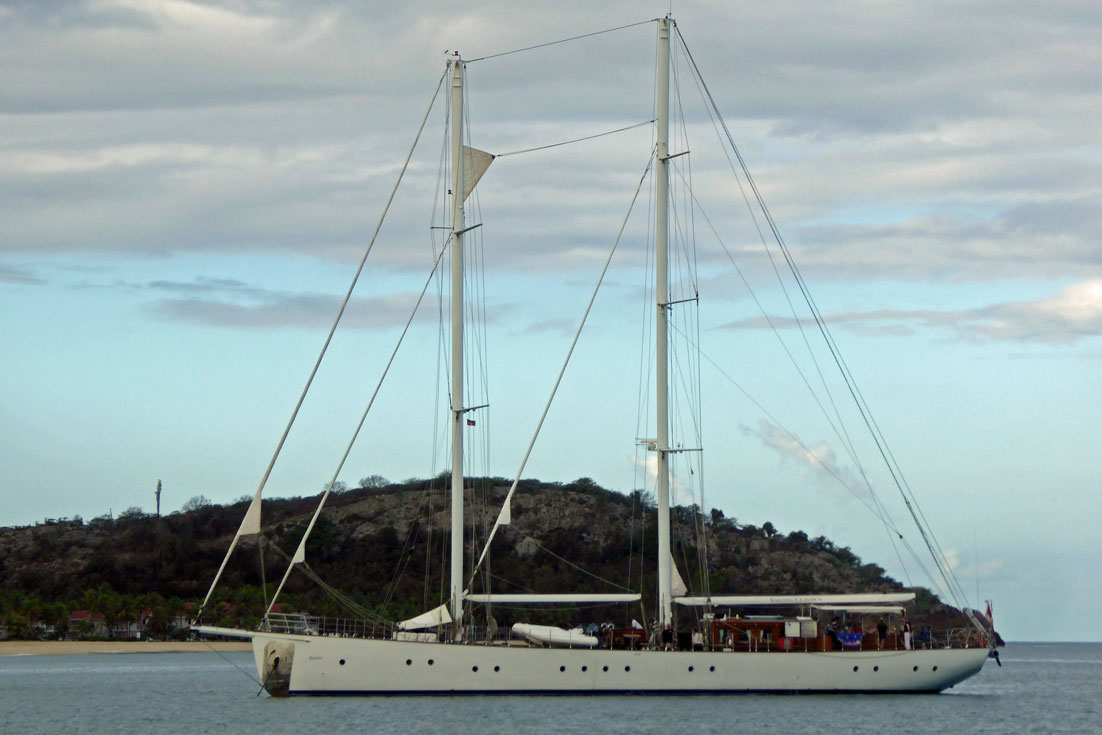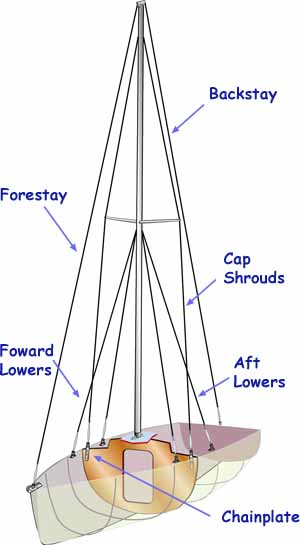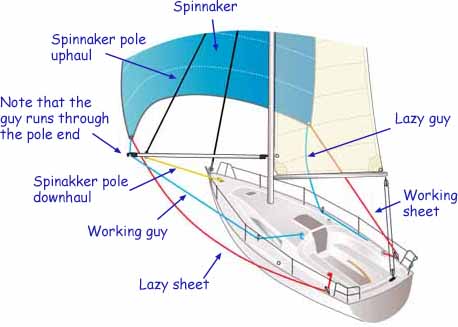- Home
- Rigging
The A-Z of Sailboat Rigging: A Guide to Standing & Running Rigging
In a Nutshell...
Sailboat rigging is the system of wires, ropes, and components that supports the mast and controls the sails. It's divided into two main categories: standing rigging and running rigging. Standing rigging, which includes shrouds, stays, and forestays, is the static support system that holds the mast upright. Running rigging, which includes halyards, sheets, and control lines, is the dynamic system used to hoist, trim, and adjust the sails. Understanding the function and maintenance of both is crucial for safety and performance.
 Running and standing rigging in extremis!
Running and standing rigging in extremis!Table of Contents
Standing, or Running Rigging?
The Backbone of Your Sailboat: Understanding Standing Rigging
As an experienced ocean sailor, I've learned that you ignore your standing rigging at your peril. It's the silent, unsung hero of your sailboat—the collection of wires, rods, and fittings that hold your mast securely in place against the immense forces exerted by the wind and sea. Unlike the sheets and halyards you handle daily, standing rigging is a static system. It's there to do one job: keep your mast standing tall.
The condition of standing rigging is critical for the safety of the vessel and the crew, For a deeper look, read our "Inspecting & Maintaining your Standing Rigging".
Proper care extends the life of your entire rigging system, from the mast to the stays. Beyond basic inspections, having the skills to make minor repairs at sea is invaluable.
A typical standing rigging setup includes:
- Shrouds: These are the wires running from the mast to the sides of the hull. They are your primary lateral support, preventing the mast from swaying side-to-side. You'll often see upper shrouds and lower shrouds, each serving a specific purpose in distributing the load.
- Stays: These run from the mast to the bow and stern. The forestay and backstay are critical for providing longitudinal support, stopping the mast from falling backward or forward. On a cutter rig, you'll also find an inner forestay.
- Chainplates: These are the heavy-duty metal plates bolted to the hull to which the shrouds and stays are attached. They are a critical, but often overlooked, part of the system.
- Turnbuckles & Toggles: These components allow you to adjust the tension of your standing rigging, a process known as tuning the rig. Proper tension is vital for sail shape and overall performance. Read our article The Complete Guide to Standing Rigging & Mast Tuning which sets out how to do this.
Maintenance is key. After a long passage, my first task is always a thorough visual inspection of the standing rigging. I'm looking for broken wire strands (called "meat hooks"), corrosion, or bent fittings. For offshore sailors, it’s a good practice to replace a boat’s standing rigging every 10 to 15 years, regardless of its apparent condition.
 Naming the parts
Naming the partsThe standing rigging on most cruising sailboat is made up with 1x19 stainless wire, but there are other options available, rod rigging for example, and Dyneema. For a deep dive on these options, take a look at Stainless Steel vs Rod Rigging: Choosing the right Material.
The Workhorse of Your Sailboat: Exploring Running Rigging
If standing rigging is the skeleton, then running rigging is the muscle. This is the dynamic part of the system that you, as a sailor, interact with constantly. Running rigging is composed of ropes (or 'lines' in sailing parlance) that are used to raise, lower, and control the sails.
The primary components of running rigging include:
- Halyards: These lines are used to hoist sails. A main halyard pulls up the mainsail, and a jib or genoa halyard hoists the headsail.
- Sheets: These are the lines used to control the trim of the sails. The mainsheet controls the boom and, by extension, the mainsail, while jib sheets control the headsail.
- Control Lines: This is a broad category that includes everything from the vang (which controls the downward force on the boom) and outhaul (which tensions the foot of the mainsail) to reefing lines (used to reduce sail area in heavy winds). For a deeper look, read Essential Mainsail Controls: Outhaul & Reefing Systems Explained.
- Blocks & Winches: These are the mechanical components that make it possible to manage the immense loads on the lines. Blocks act as pulleys, while winches provide the mechanical advantage needed to trim sails or tension halyards. It's a good idea to periodically assess your winches to ensure they are still meeting the demands of your sailing. So could it be Time to Upgrade your Sailboat Winches?
A boat's running rigging is essential for controlling the sails. While a basic understanding is crucial, a deeper dive into the specific components & their functions can greatly improve your sailing performance & safety. To learn more, check out our detailed guide: Running Rigging Explained: Halyards, Sheets & Guys.
Unlike standing rigging, running rigging is typically replaced more frequently due to wear and tear. A frayed halyard or a worn-out sheet can fail at the worst possible moment, so I’m always mindful of replacing lines as soon as they show signs of significant chafe or UV damage. My personal rule of thumb is to inspect and replace my running rigging every 5 to 7 years, or sooner if needed. I always carry spare lines of various diameters onboard, especially on long-distance trips, for emergency repairs.
 Uphaul, downhaul, sheets and guys required if you fly a spinnaker!
Uphaul, downhaul, sheets and guys required if you fly a spinnaker!Various materials are available for running rigging. For an explanation of why this is so, take a look at A Guide to Marine Cordage: Choosing the Right Ropes for Halyards & Sheets.
Masts, Booms, & Spars: The Foundation
No discussion of rigging would be complete without mentioning the mast and spars. The mast is the primary vertical spar, the tall pole from which your sails are set. A boom is the horizontal spar attached to the mast that extends the foot of the mainsail. Other spars might include a spinnaker pole or a bowsprit. Masts are typically made of aluminum, carbon fiber, or wood, each with its own advantages in terms of weight, strength, and cost.
Modern masts are often a 'keel-stepped' design, meaning they extend through the deck and rest on the keel, or a 'deck-stepped' design, which sits on the deck and is supported by a compression post below. There are pros and cons for each solution, which are discussed in detail in Mast Stepping 101: A Guide to Deck-Stepped vs. Keel-Stepped Masts.
Spar Materials
For an expansion on the above table, read Aluminium, Carbon Fibre, or Wood? Choosing a Mast.
The B&R Rig: A Modern Departure
While most traditional yachts employ a standing rigging setup that uses a backstay to support the mast longitudinally, some modern designs—most famously those by Hunter and certain Catalina models—feature the proprietary B&R rig (named after its designers, Lars Bergström and Sven Ridder).
This fractional rig is immediately recognisable because it has no backstay. Instead, it achieves its incredible mast support through two critical features:
- Highly Swept-Back Spreaders: The spreaders sweep dramatically aft, usually at an angle of between 30 and 35 degrees. This geometry transfers the forces from the upper shrouds both laterally and longitudinally, acting as a functional replacement for the backstay.
- Stout Shrouds: The standing rigging wires themselves are often oversized and tensioned much tighter than on a conventional rig.
The primary benefit of the B&R rig is its strength and the reduction of clutter in the cockpit. However, its tuning is fundamentally different. Standard mast tuning methods do not apply, and it is vital that owners follow the manufacturer's specific instructions to maintain correct pre-bend and tension, as all forces are managed through the fixed geometry of the shrouds and spreaders.
For much more on the B&R rig, including its pros and cons, take a look at our in-depth article "The B&R Rig: Unlocking the Secrets of Hunter Sailboats' Unique Mast".
This article was written by Dick McClary, RYA Yachtmaster and author of the RYA publications 'Offshore Sailing' and 'Fishing Afloat', member of The Yachting Journalists Association (YJA), and erstwhile member of the Ocean Cruising Club (OCC).
Frequently Asked Questions
What's the difference between a stay and a shroud?
What's the difference between a stay and a shroud?
A stay runs fore-and-aft (forward and backward) from the mast, providing longitudinal support. A shroud runs athwartships (side-to-side), providing lateral support.
How often should I replace my standing rigging?
How often should I replace my standing rigging?
For recreational sailors, a common recommendation is to replace stainless steel wire standing rigging every 10-15 years, or sooner if any signs of corrosion or damage are visible.
What is a turnbuckle?
What is a turnbuckle?
A turnbuckle is a mechanical device used to adjust the tension of the standing rigging. It has a threaded body and two threaded terminals that are turned to either lengthen or shorten the assembly.
What is a halyard?
What is a halyard?
A halyard is a line used to hoist a sail up the mast. The mainsail has a main halyard, and a headsail has a jib or genoa halyard.
Resources Used
- Royal Yachting Association (RYA): https://www.rya.org.uk/
- UK Sailing (UKS): https://uks.co.uk/
Recent Articles
-
Planning Your Sailboat Liveaboard Lifestyle: An Ocean Sailor's Guide
Dec 06, 25 05:18 AM
Seasoned sailors share their methodical risk analysis for planning a secure Sailboat Liveaboard Lifestyle, covering financial, property, and relationship risks. -
Marine Cabin Heaters: The Expert’s Guide to Comfort & Safety at Sea
Dec 05, 25 06:52 AM
Choose the best Marine Cabin Heaters for your vessel. Expert advice on diesel, paraffin, and hot water systems for year-round cruising comfort. -
Marine Water Heating Systems: Free Hot Water from Your Boat's Engine
Dec 03, 25 05:06 PM
Tap into your engine's heat to get free hot water on board. An experienced ocean sailor's guide to marine water heating systems, calorifiers & safety.












